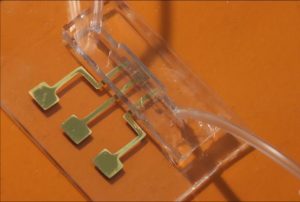Nanomaterial-Based Biosensor for COVID-19 Antibodies
Written By: Kaylee Zhou
Carnegie Mellon and the University of Pittsburgh’s investigators have recently partnered together to create a nanomaterial-based biosensor platform. Their creation can detect the presence of COVID-19 antibodies in mere seconds. The platform can not only quickly identify if a patient has been previously infected and built up resistance against COVID-19, but also assist in testing whether patients are appropriately responding to the newly approved vaccines (ClinicalOMICs, 2021). This biosensor’s detection allows scientists to learn more about not only COVID-19 antibodies but also antibodies present in many other dieases such as HIV, Ebola, and the Zika virus.
Biosensor Platform Construction
Rahul Panat, an associate professor at Carnegie Mellon and a contributor toward the biosensor’s creation, said, “We utilized the latest advances in materials and manufacturing such as nanoparticle 3D printing towards our device” (Kulick, 2021). In fact, the investigators selected aerosol jet 3D printing as their primary manufacturing technology. The aerosol jet printing process focuses on using aerodynamics to precisely place electronic inks onto a surface (Optomec, 2018). Since the biosensor platform utilized 3D printing, the aerodynamics would be placing a different material onto the surface. By applying this technology, the investigators used aerosol droplets, which were thermally sinistered, to create small gold micropillar electrodes (Meara, 2021). This meant that the aerosol droplet particles were bonded together until a solid structure, which was the micropillar electrodes, were able to form.
Figure 1

This is an image of the Biosensor Platform that has been made by nanoparticle 3D printing.
Advanced Manufacturing and Materials Lab, College of Engineering, Carnegie Mellon University. (2021). 3D Printed COVID-19 Test Chip. https://www.eurekalert.org/multimedia/pub/253000.php
How does it work?
After the electrodes are produced, a layer of antigen is coated onto them. The platform samples use very small blood droplets, sometimes as little as five microliters, to apply onto the electrodes (ClinicalOMICs, 2021). From this blood, the biosensor is able to detect if either the S1 protein or the receptor-binding domain (RBD), which are two of COVID-19’s antibodies, are present (Kulick, 2021). The previously-mentioned coated antigen is a substance that is capable of provoking an immune response; therefore, if either the S1 protein or the receptor-binding domain binds to the coated antigen, it would prove that antibodies are present. The platform knows when to send a positive antibody alert to a connected smartphone or computer because the device’s electrical currents are altered when a bind occurs (ClinicalOMICs, 2021). Furthermore, the produced electrodes have both an enhanced electrochemical reaction and a large geometric shape that provides an opportunity for more proteins to latch onto the micropillars, resulting in more accurate detections (Meara, 2021).
Testing Accuracy
As the investigators researched and experimented with their biosensor, they realized that the antibody and antigen bind was very selective, so they took advantage of this natural occurrence (Kulick, 2021). They then elaborated on their low error rate by explaining the electrode regeneration process. The electrodes’ sensors were regenerated and refreshed using a low pH solution, such as acidic water, to release the antibody from the antigen (Meara, 2021).
Conclusion
The investigators emphasized that since their biosensor device is generic, it has the capability to test for other diseases apart from COVID-19, such as HIV, Ebola, and the Zika virus. Professor Panat has stated, “Because our technique can quantify the immune response to vaccination, it is very relevant in the current environment” (Meara, 2021). This biosensor breakthrough will be essential for the control and spread of COVID-19 and other diseases.
References and Sources
ClinicalOMICs. (2021, January 11). Nanomaterial-Based Biosensor Can Detect COVID-19 Antibodies in Seconds. Retrieved January 22, 2021, from https://www.clinicalomics.com/topics/patient-care/coronavirus/nanomaterial-based-biosensor-can-detect-covid-19-antibodies-in-seconds/
Kulick, L. (2021). Detecting COVID-19 antibodies in 10-12 seconds. Retrieved January 22, 2021, from https://www.eurekalert.org/pub_releases/2021-01/coec-dc010721.php
Meara, K. (2021). 3D Printed Electrodes Detect COVID-19 Antibodies in Seconds. Retrieved January 22, 2021, from https://www.contagionlive.com/view/3d-printed-electrodes-detect-covid-19-antibodies-in-seconds
Optomec. (2018, August 02). 3D Printed Electronics – Aerosol Jet Technology . Retrieved January 22, 2021, from http://optomec.com/printed-electronics/aerosol-jet-technology/#:~:text=The%20Aerosol%20Jet%20process%20uses,5%20microns%20diameter%20(2).&text=Printed%20features%20range%20from%2010%20microns%20to%20millimeters